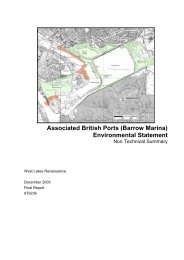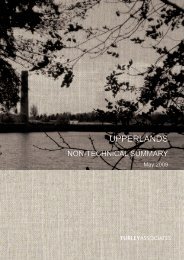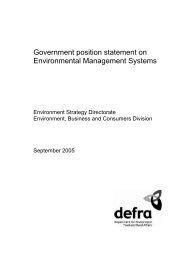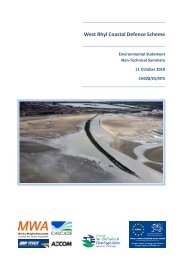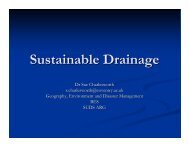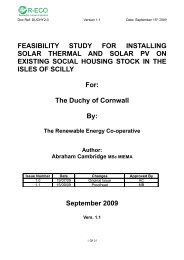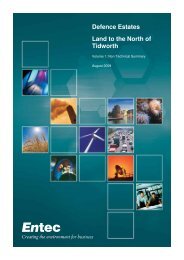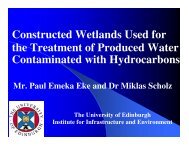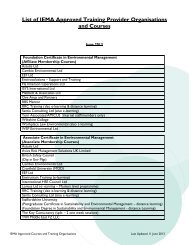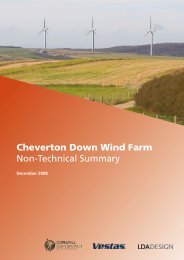Environment Law Bulletin - Institute of Environmental Management ...
Environment Law Bulletin - Institute of Environmental Management ...
Environment Law Bulletin - Institute of Environmental Management ...
Create successful ePaper yourself
Turn your PDF publications into a flip-book with our unique Google optimized e-Paper software.
“The time limit for full and transfer licences is notprescribed in the Water Bill, but the <strong>Environment</strong>Agency has indicated that the period will generally betwelve years.”water abstractors is that the Governmentconsiders that the Water Bill amendmentswill be “largely sufficient” to bring Englandand Wales into line with the WaterFramework Directive in this respect. TheWater Framework Directive requires“controls over the abstraction <strong>of</strong> freshsurface water and groundwater, andimpoundment <strong>of</strong> fresh surface water,including a register or registers <strong>of</strong> waterabstractions and the requirement <strong>of</strong> priorauthorisation for abstraction and impoundment”(Article 11(3)(e)). One area <strong>of</strong>potential difference, however, that theGovernment is currently considering iswhether the Water Framework Directiverequires abstraction and impoundmentcontrols to extend to certain self-containedlakes and reservoirs – which are currentlyexcluded from the key “source <strong>of</strong> supply”definition in the Water Resources Act 1991(“WRA 1991”).The abstraction provisions <strong>of</strong> the WaterBill have been designed in part as substantialamendments to the existing provisionsin Chapter II <strong>of</strong> the WRA 1991 and in partas stand-alone provisions (at times, thelogic behind this division is unclear, and itcertainly does not make for an easily readablebill). Although there is, <strong>of</strong> course, thepotential for these provisions to beamended as they pass through the House<strong>of</strong> Lords and House <strong>of</strong> Commons, some <strong>of</strong>the key changes proposed by theGovernment are set out below.New licencesAll new abstraction licences will be classifiedas one <strong>of</strong> three types: a temporary licence, covering abstractionover a period <strong>of</strong> less than 28 days;a transfer licence, applying to theabstraction <strong>of</strong> water from one source inorder to transfer it to another withoutintervening use over a period <strong>of</strong> 28days or more; or a full licence, which will apply to theabstraction <strong>of</strong> water from one source <strong>of</strong>supply over a period <strong>of</strong> 28 days or morefor any purpose.Every licence will have to state the purposesfor which the water is to be used and thedate on which the licence expires. The timelimit for full and transfer licences is notprescribed in the Water Bill, but the<strong>Environment</strong> Agency has indicated that theperiod will generally be twelve years. This hascaused some concern amongst water undertakersand those investing in water-relatedinfrastructure, such as hydropower operators.In response, the Government has said that insuch cases it may be possible to make thecase for the grant <strong>of</strong> a longer licence.Full licences will (and transfer licencesmay) also specify a “minimum value” forthe quantity <strong>of</strong> water to be abstracted. Thisis not a minimum amount that must beabstracted but rather the smallest quantityto which the licence holder can berestricted in certain circumstances withoutthe <strong>Environment</strong> Agency being required topay compensation (as discussed furtherbelow). This therefore has the potential tobe a very significant figure.Thresholds andexemptionsThe Water Bill increases the threshold forexemption from abstraction licensing from5m 3 to 20m 3 per day. There are around48,000 abstraction licences at present andthis move is expected to remove some20,000 <strong>of</strong> those abstractions from therequirement to be licensed. At the sametime, the Bill also provides powers torevoke existing statutory exemptions fromabstraction licensing, such those relating toparticular areas and made under local orprivate acts. From discussions with DEFRA,it appears that the intention is to revokesuch statutory exemptions over a number<strong>of</strong> years after the Water Bill comes int<strong>of</strong>orce, with the ultimate intention <strong>of</strong>removing all current statutory exemptions.The 20m 3 exemption will itself be subjectto powers enabling the Secretary <strong>of</strong> State toraise or lower it in relation to a specificgeographical area and/or class <strong>of</strong> inlandwater or underground strata. It is likely thatthe policy behind this provision is, in part atleast, driven by the need for greater flexibilityin order to comply with the outcome–basedapproach <strong>of</strong> the Water Framework Directive.Unlike the Water Bill, the Water FrameworkDirective does not provide for an absoluteminimum threshold but instead provides thatMember States can exempt abstractions orimpoundments “which have no significantimpact on water status”.Protected rightsOne <strong>of</strong> the ramifications <strong>of</strong> the creation <strong>of</strong>the three types <strong>of</strong> abstraction licence isthat only the full licence will have thebenefit <strong>of</strong> existing provisions providingprotection against the <strong>Environment</strong> Agencygranting new licences that derogate froman existing licence holder’s rights. However,the Water Bill preserves the existing situationunder which certain unlicensedabstractions are also treated as“protected rights” (broadly, wheregroundwater is abstracted by an indi-9<strong>Environment</strong> <strong>Law</strong> <strong>Bulletin</strong>April 2003



